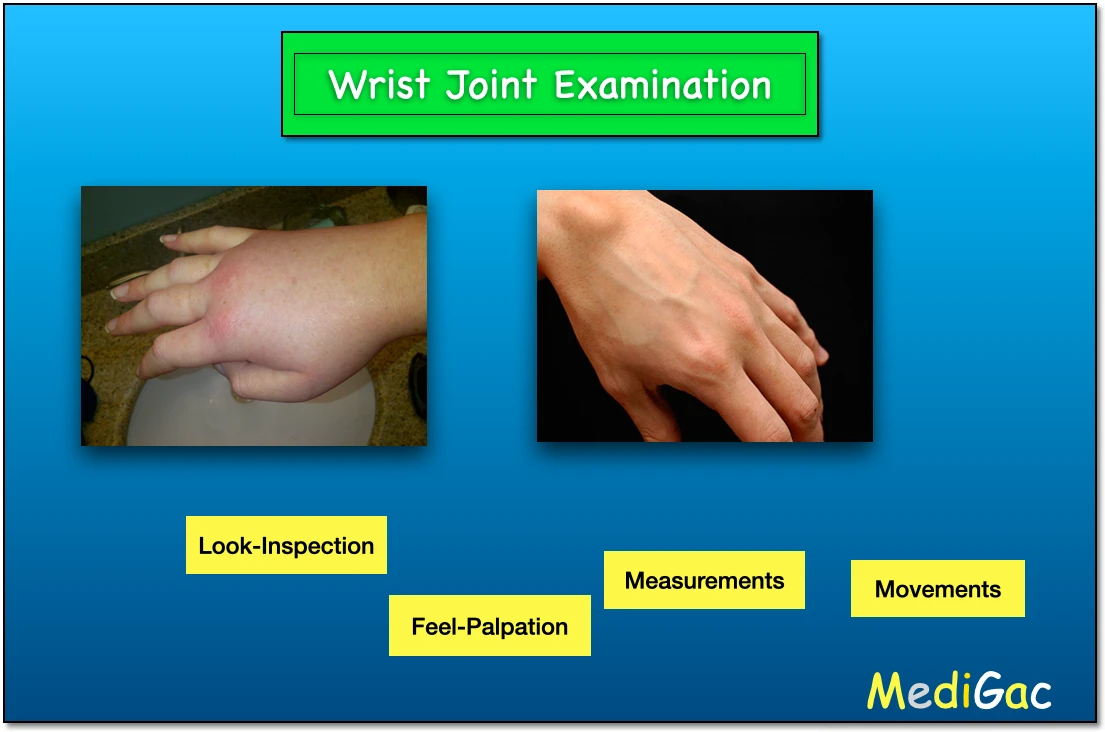
I. ‘Look’ or ‘Inspection’ of wrist joint :
1. Attitude or Deformity :
To check this, we can find various deformities like :
- Wrist drop – This can occur due to radial nerve palsy
- Benett’s fracture – This is the abnormal prominence of 1st metacarpal on the lateral side
- Claw hand – Due to ulnar nerve palsy
- Malunited colles fracture – This is the abnormal prominence of the ulnar head
2. Swelling :
There are some common diseases which can cause of an abnormal swelling.
- De quervain’s disease – This can occur due to Inflammation of the tendon sheath, which joins the muscle to the bone that is tendosynovitis.
- Rheumatoid arthritis – This occurs due to any joint inflammation.
- Bouchard’s nodule – This can be due to swelling over the proximal inter phalangeal joint.
- Lunate dislocation – This can occur due to small mid-wrist solar swelling.
3. Wasting :
Incase of wasting, we have to see this things :
- Fore arm muscles
- Median nerve palsy, Carpal tunnel syndrome – Thenar eminence wasting
- Ulnar nerve palsy – Hypothenar eminence
II. ‘Feel’ or ‘Palpation’ of wrist joint :
1. Swelling :
The examiner can palpate few some things like :
- Tenosynovitis
- Synovial thickening in rheumatoid arthritis
- Thyroid disease
- Compound palmar ganglion
2. Temperature :
- The examiner uses the back of the dominant hand to feel and compare the temperature, first at normal wrist, second at abdominal wrist and then the normal wrist.
- Serially from the dorsal, velar, radial and ulnar side of the wrist.
3. Tenderness :
During the palpation of the tenderness, we have to find out at different places :
- Smith’s fracture & Barton’s fracture
- Bennett’s fracture
- Scaphoid fracture, and the distal 1/4th of the radius
- The distal radio-ulnar joint
5. Joint line :
- At the Inter styloid line, the examiner can feel a gap.
- The gap opens and closes with wrist movement
- This is known as the dorsal joint line of the wrist
6. Distal radio-ulnar joint instability :
Also known as Piano key sign.
- With one hand, the examiner attempts to subluxate the DRUJ by applying volarly directed stress on the ulnar head and looking for aberrant movement.
- Then notes and compares the the opposite site also.
- Finally comments on the matter.
III. Movements of wrist joint :
1. Radio Ulnar deviation :
- The examiner flex the patient’s elbow to 90 degrees, with the forearm pronated.
- The examiner grasps the patients forearm with one hand, and the palm with the opposite hand.
- Then the examiner gradually deviates the hand first medially and then laterally, to make sure that there is no palmar flexion or dorsiflexion.
2. Dorsiflexion :
- The patient is asked to make a prayer like hand with both the thenar and hypothenar part of the hand touch their counterparts.
- Then the patient is requested to maintain the palm contact and simultaneously elevate also.
- This is the dorsiflexion, now the examiner notes and comments.
3. Palmarflexion :
- Now here the patient is requested to contact both the dorsum of the wrist, hand and fingers.
- Then, The patient is requested to lower the elbow gradually.
- This is the Palmar flexion. now the examiner notes and comments.
IV. Measurement of wrist joint :
1. Linear measurement :
- In linear measurement, we used to measure the length of the forearm.
2. Circumferential measurement :
- By this measurement we measure the muscle wasting or swelling
- The girth of the wrist and forearm is measured
VI. What are the special tests
- Muscle testing
- Maisonneuve’s test – This test is done to confirm the hyperextension at the pathological wrist joint.
- Grip test
- Grind test
- Flexor digitorum superficialis (FDS)
- FLP(Flexor pollicis longus)+ EPL(Extensor pollicis longus)
- Bunnell-Littler test
- Watson test